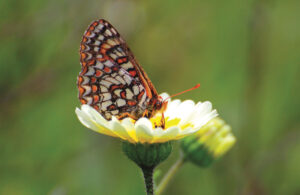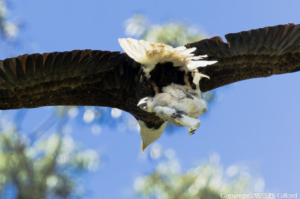What’s that up in the sky?! It’s a bird, it’s a … yep, it’s a bird!
Look upward at this time of year and there’s a good chance you’ll spot some male hummingbirds zooming around and putting on quite a show for the ladies. One thing leads to another and before you know it, the babies arrive!
Hummingbirds are the smallest birds in the world and only live in the Americas. To make their golf-ball sized nests, they forgo hard and pointy materials like twigs, and go for maximum comfort for their delicate chicks: spider silk, plant down, moss, feathers, pieces of leaves, and lichens (for camouflage).
Have you ever wondered why baby hummingbirds seem packed just-so in their nests? It’s because as they grow and move around, the nest is able to expand thanks to the elasticity and strength of the cobwebs that bind the nest material together.
It’s close quarters, but these little birds aren’t stuck in there for long. About 18 to 30 days after they hatch, they take flight and like a baby learning to walk, they’re not always successful with the first try.
“People often call us about fledglings they find on the ground,” says Susan Heckly, wildlife rehabilitation director at Lindsay Wildlife Museum in Walnut Creek.
Heckly said it’s good to move them out of harm’s way, but not far (Contrary to popular myth, a mother bird will not reject a chick if a human handles it. But keep contact to a minimum to avoid the spread of disease).
“These hummingbirds are still learning to fly and mom’s probably somewhere nearby keeping an eye on them,” she says. “If the bird seems okay otherwise, try to put it somewhere up off the ground, preferably a tree, where it can perch. Then back off and keep an eye on it for about an hour. Mom should be back to feed her baby every 20 to 30 minutes.”
Spring tree trimming and cats are the primary reasons hummingbirds are injured and brought in for rehab.
“People are surprised when they learn that cats can pluck these speedy little birds out of the air,” says Rose Britton, animal care director at Sulphur Creek Nature Center in Hayward. “But hummingbirds hover near flowers, sometimes very close to the ground, and that’s how they get caught.”
Flowers, however, are still preferable to hummingbird feeders.
“If you decide to put up a hummingbird feeder, it’s really important to clean it every few days,” says Heckly. “The sugar solution will quickly ferment, mold, or attract mites, all of which can make hummingbirds very sick. Feeders can also spread disease in bird populations if not cleaned properly.”
Yuck! Rather than put up a feeder, it’s best to look to grow a hummingbird garden.
“If you want to attract hummingbirds, it’s best to grow things they like,” says Britton. “You can start by going to a native plant nursery and asking what attracts hummingbirds. I have hummingbirds in my yard year-round because of what I’ve planted, and I don’t have to bother with cleaning a feeder all the time!”
[slideshow]
Constance Taylor is a Bay Nature editorial intern.





